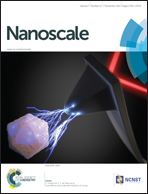Localization of adhesins on the surface of a pathogenic bacterial envelope through atomic force microscopy†
Abstract
Bacterial adhesion is the first and a significant step in establishing infection. This adhesion normally occurs in the presence of flow of fluids. Therefore, bacterial adhesins must be able to provide high strength interactions with their target surface in order to maintain the adhered bacteria under hydromechanical stressing conditions. In the case of B. pertussis, a Gram-negative bacterium responsible for pertussis, a highly contagious human respiratory tract infection, an important protein participating in the adhesion process is a 220 kDa adhesin named filamentous haemagglutinin (FHA), an outer membrane and also secreted protein that contains recognition domains to adhere to ciliated respiratory epithelial cells and macrophages. In this work, we obtained information on the cell-surface localization and distribution of the B. pertussis adhesin FHA using an antibody-functionalized AFM tip. Through the analysis of specific molecular recognition events we built a map of the spatial distribution of the adhesin which revealed a non-homogeneous pattern. Moreover, our experiments showed a force induced reorganization of the adhesin on the surface of the cells, which could explain a reinforced adhesive response under external forces. This single-molecule information contributes to the understanding of basic molecular mechanisms used by bacterial pathogens to cause infectious disease and to gain insights into the structural features by which adhesins can act as force sensors under mechanical shear conditions.


 Please wait while we load your content...
Please wait while we load your content...